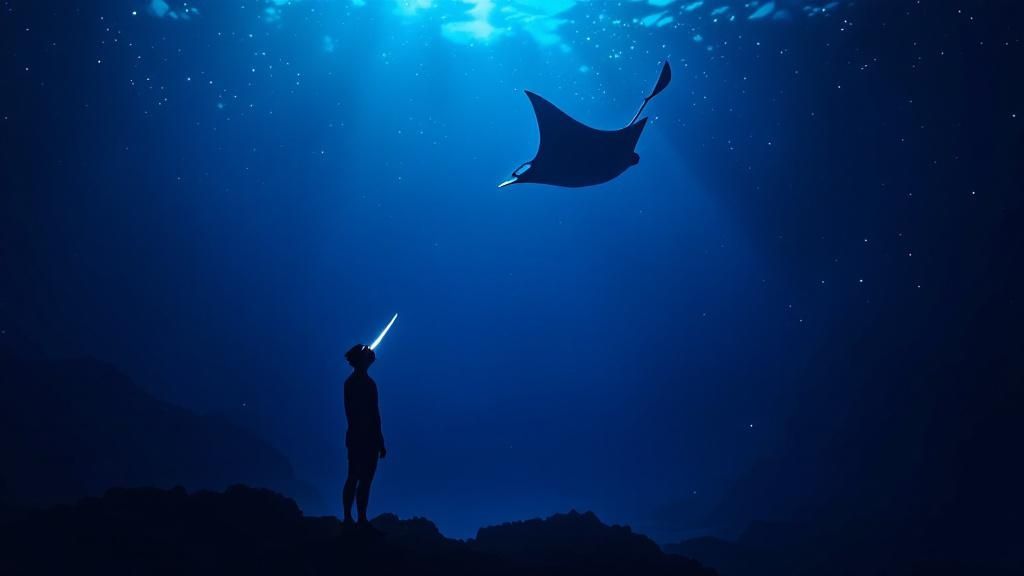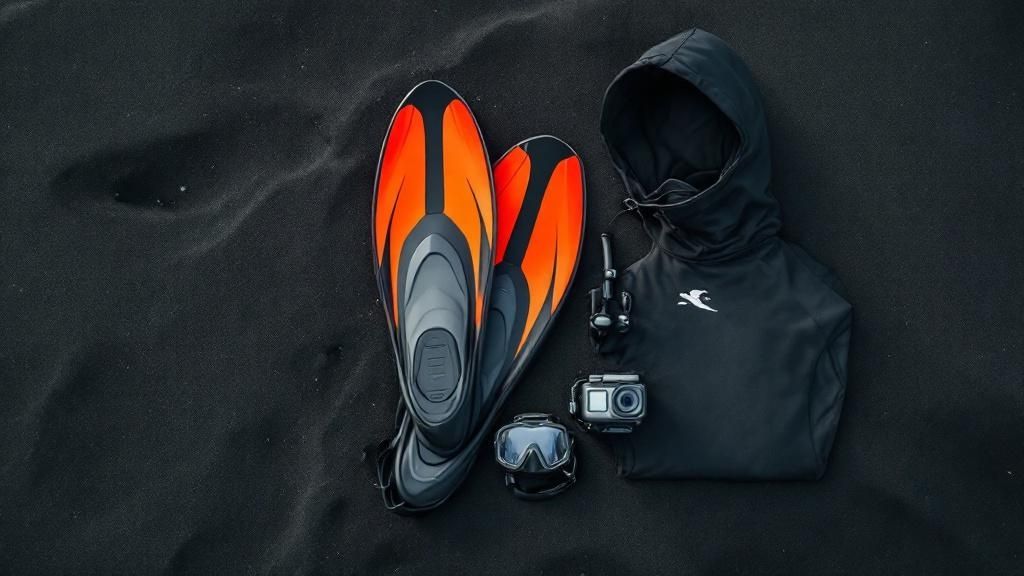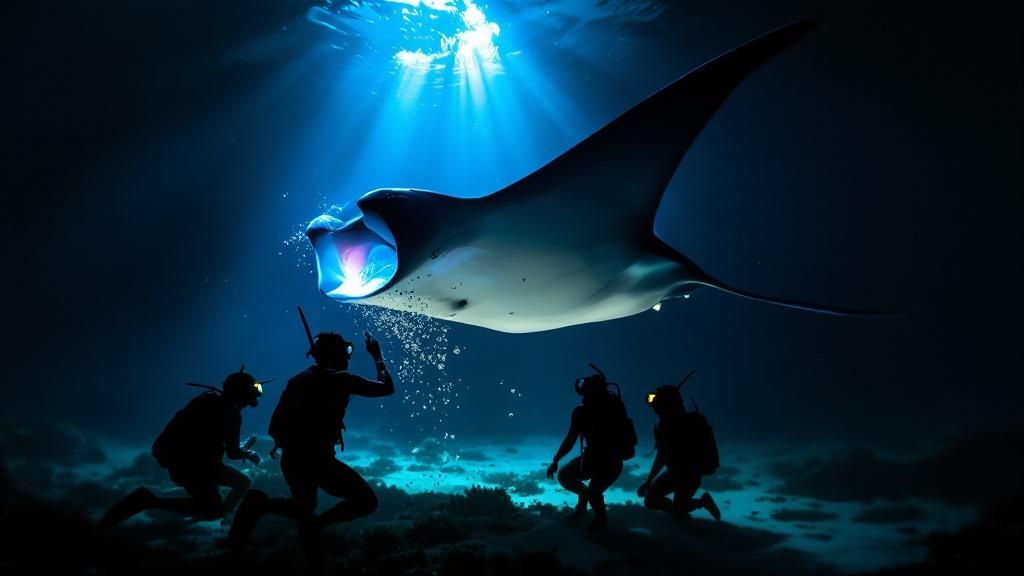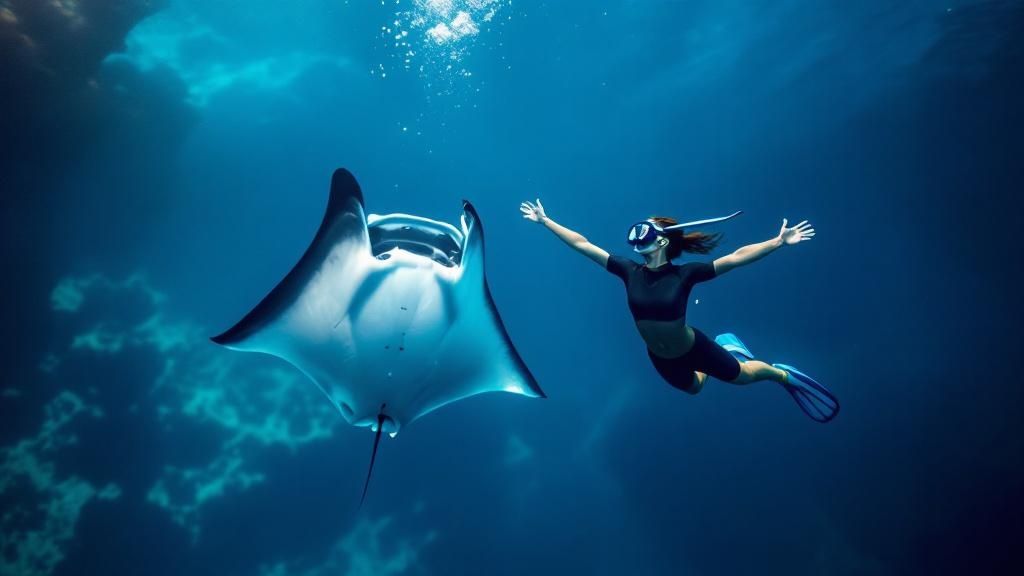Manta Ray Snorkel Kona: Your Ultimate Hawaii Adventure Guide
- Byron
- May 31
- 12 min read
Why Kona Is The World's Manta Ray Capital

Kona's reputation as a manta ray haven is well-deserved. It's a unique combination of geological and oceanographic factors that create the perfect habitat for these gentle giants. This makes a manta ray snorkel Kona experience truly special. The island's volcanic origins play a vital role in this rich ecosystem.
Volcanic Upwellings and Nutrient-Rich Currents
Volcanic activity below the ocean floor creates upwellings. These upwellings bring nutrient-rich waters to the surface, fueling the growth of plankton. Plankton are microscopic organisms that serve as the main food source for manta rays. Ocean currents circulating around the Big Island further enhance this environment by delivering a continuous supply of plankton. This constant food source attracts and supports a large, resident population of manta rays.
The Manta Ray Feeding Frenzy: A Nightly Spectacle
Manta rays feed at night, and Kona offers a unique opportunity to witness their nightly dining rituals. The plankton are drawn to light, particularly the lights used by snorkel tour operators. This creates a spectacular feeding frenzy, with manta rays gracefully gliding and looping through the illuminated water. This mesmerizing display attracts thousands of visitors annually.
Kona, Hawaii attracts approximately 80,000 manta ray snorkel participants each year. With a sighting success rate between 80% and 90%, this means that roughly 8 to 9 out of every 10 snorkelers have the chance to witness these magnificent creatures. Find more detailed statistics here. This incredible predictability further solidifies Kona's global reputation as the best place for manta ray snorkeling.
A Unique and Predictable Wildlife Encounter
The combination of nutrient-rich waters, predictable feeding patterns, and clear visibility makes Kona an exceptional place to encounter manta rays. Unlike other locations where sightings are less consistent, Kona provides an almost guaranteed opportunity to observe these majestic creatures up close. This reliable access, coupled with the breathtaking experience, explains why Kona is often called the "Manta Ray Capital of the World." It’s an unforgettable experience for anyone lucky enough to witness it.
Your Real Chances Of Seeing Manta Rays
Experiencing a manta ray snorkel adventure in Kona is a dream for many. While no wildlife tour can offer a 100% guarantee, Kona boasts an impressive success rate. You have an 85% to 90% chance of seeing these gentle giants, meaning most tours lead to magical encounters. So, what contributes to Kona's consistent success?
Kona's Resident Manta Ray Population
One major factor is Kona's thriving manta ray population. Researchers have identified over 450 individual manta rays, each with unique markings. This large, resident population significantly boosts your chances of a memorable encounter during your snorkel tour.
Environmental Factors Influencing Sightings
While Kona's success rate is high, it's good to understand the role of nature. Environmental factors like water clarity and current strength can influence manta ray behavior and visibility. Calmer waters generally offer better viewing. Even in less ideal conditions, experienced guides leverage their knowledge of the manta rays' favorite haunts to maximize your chances. Kona’s unique coastal features support year-round sightings, a rare phenomenon for predictable underwater wildlife encounters. Learn more about manta ray sightings.
Duration and Intensity of Encounters
Almost every manta ray snorkel tour in Kona reports sightings. However, the duration and intensity of these encounters can differ. Some tours may offer brief glimpses, while others provide extended observation periods. It’s similar to birdwatching. Sometimes you catch a quick shadow, other times you enjoy minutes of close-up observation. Factors like plankton availability and ocean currents influence the manta rays’ behavior.
Realistic Expectations and Unique Experiences
Setting realistic expectations enhances your manta ray experience. Each encounter is unique, shaped by natural factors. While duration and intensity can vary, Kona’s high sighting probability makes it an exceptional adventure. The predictability, combined with local guides' expertise, ensures a memorable and inspiring experience.
Best Snorkel Sites For Manta Ray Encounters

Not all manta ray viewing locations are the same. Knowing what makes each site unique will help you plan the best possible manta ray snorkel Kona experience. From the shallow waters of Manta Village, perfect for beginners, to the deeper, more adventurous Manta Heaven, Kona has something for everyone.
Manta Village: The Original Hotspot
Manta Village, located in Keauhou Bay, is known as the original manta ray viewing spot. The rays gather here, drawn by the lights from nearby hotels. The bay is relatively shallow, generally less than 40 feet deep. This makes it a great spot for beginners and families. The calm water also typically offers excellent visibility, so even less experienced snorkelers can comfortably enjoy the magic.
Manta Heaven: A Deeper Dive
Manta Heaven, off the Kona International Airport, offers a more thrilling experience for seasoned snorkelers. The waters here are deeper, often exceeding 50 feet. This requires more confidence in open water, but the reward can be incredible: larger groups of manta rays performing their captivating feeding loops. The increased depth often gives you a whole new perspective on these graceful giants.
Other Viewing Locations: Off the Beaten Path
While Manta Village and Manta Heaven are the most well-known spots, other viewing sites exist near the Kohala Coast resorts. These locations can offer a less crowded experience, though manta ray sightings might be less frequent. This is a great option for those looking for a more intimate encounter.
To help you choose the perfect spot, we've created a comparison table summarizing the key features of each location:
Kona Manta Ray Snorkel Sites Comparison: Comparison of the top manta ray snorkeling locations in Kona, showing depth, difficulty level, and unique features.
Site Name | Water Depth | Skill Level | Best Features | Typical Group Size |
|---|---|---|---|---|
Manta Village | <40 ft | Beginner | Calm, shallow water, good for families | Large |
Manta Heaven | >50 ft | Intermediate/Advanced | Deeper water, potential for larger manta ray groups | Medium |
Kohala Coast Resorts | Varies | Varies | Less crowded, more intimate experience | Small |
This table gives you a quick overview of the different snorkeling sites and helps you choose the best one based on your experience level and what you're hoping to see.
Choosing the Right Site for Your Skill Level
Choosing the right site contributes to both your enjoyment and safety. If you're a beginner, start at Manta Village. The shallow, calm waters are ideal. Families with young children, for example, will appreciate the easier conditions. More experienced snorkelers looking for larger groups of manta rays and deeper dives might prefer Manta Heaven. Every site offers a unique experience, so consider your comfort level and skill when making your choice.
Maximizing Your Manta Ray Experience
No matter which location you choose, a few strategies can improve your viewing experience. Positioning yourself correctly is key. At Manta Village, snorkelers often hold onto a floating board equipped with lights, creating a perfect viewing platform. At Manta Heaven, you might sit on the ocean floor and watch the manta rays glide above. Respectful wildlife viewing is essential. Never touch the manta rays, as their protective mucous layer is vital to their health. Patience and stillness will increase your chances of longer encounters. Finally, consider the time of year and weather conditions when planning your manta ray snorkel Kona adventure.
What Really Happens During Night Manta Adventures
Stepping beyond the glossy brochures and enticing online advertisements, let's explore the authentic experience of a manta ray night snorkel in Kona. What should you realistically expect during this unique encounter in the ocean's darkness? This section guides you through each step, from the initial boat trip to the magical moment the manta rays appear.
From Boat to Breathtaking Encounter
Your adventure starts with an exciting boat ride to a well-known manta ray viewing spot in Kona, such as Manta Village or Manta Heaven. Guides provide a briefing on manta ray behavior, safety procedures, and what to expect during the experience. As darkness falls, you'll enter the water. Submerged lights, often fixed to floating boards held by snorkelers, attract plankton, creating a captivating display. For more tips on preparing for this adventure, check out this helpful guide: How to Master the Manta Ray Snorkel Kona Experience.
The Underwater Ballet of Manta Rays
These strategically placed lights act like a dinner bell for the manta rays. Lured by the plentiful plankton, these graceful giants ascend from the deep, transforming the dark water into a mesmerizing underwater ballet. They elegantly glide and circle through the illuminated area, their vast wingspans a truly awe-inspiring sight. Observing these magnificent creatures up close, sometimes just a few feet away, is a remarkable experience.
Sensory Experience and Practical Considerations
Floating in the dark ocean, surrounded by these gentle creatures, is a unique sensory experience. The cool water, the soft glow of the lights, and the silent dance of the manta rays create a blend of excitement and tranquility. While the focus is naturally on the manta rays, it's helpful to be aware of the practical aspects. Water temperatures generally range from 75-80°F (24-27°C). Although wetsuits are provided, some people may still feel a bit chilled after 20-30 minutes in the water. Most encounters last around this duration, giving you plenty of time to observe the manta rays' feeding habits.
Managing Nighttime Water Anxiety and Enjoyment
For those unfamiliar with night snorkeling, a little apprehension is perfectly normal. Keep in mind that trained guides are there to ensure everyone's safety and well-being. Practicing deep, regular breaths can help alleviate any anxiety, enabling you to fully immerse yourself in the experience. Even if you prefer to stay on the boat, the view of these incredible creatures gliding below is still a rewarding spectacle. The entire adventure, from the boat trip to the encounter itself, is designed to be both educational and inspiring, leaving you with a profound appreciation for these gentle giants and the remarkable marine environment they inhabit.
The Conservation Story Behind Every Encounter

Your manta ray snorkel Kona adventure is more than a magical experience. It's a vital part of a larger conservation effort. The sustainable tourism built around these gentle giants is a success story over a decade in the making. This careful approach ensures future generations can also experience these incredible encounters.
Balancing Tourism and Ecosystem Protection
Kona welcomes approximately 80,000 visitors each year for manta ray encounters. Balancing this tourism with the protection of the marine ecosystem, home to over 450 resident manta rays, requires careful management. This delicate balance protects both the visitor experience and the long-term health of the manta ray population.
Research and Data Collection: The Foundation of Conservation
Systematic research and data collection are critical to this endeavor. Since at least 2009, detailed sighting statistics along the Kona coast have been carefully recorded. This data provides valuable information on manta ray populations and encounter rates. These insights inform both conservation efforts and tourism management.
This historical data helps shape policies on marine habitat protection. It ensures the estimated 80,000 annual visitors don't upset the ecological balance. Find more detailed statistics here. Long-term data collection helps researchers understand population trends and the impact of tourism, allowing them to adapt conservation strategies as needed.
Community Initiatives and Scientific Studies
Numerous policies and community initiatives help safeguard the manta rays and their habitat. Some examples include regulations on boat traffic and lighting during night tours and promoting responsible viewing practices. Ongoing scientific studies also play a critical role.
These combined efforts create a sustainable approach to manta ray tourism. They minimize disturbances while maximizing educational and economic benefits for the community.
Your Contribution to Conservation
When you participate in a manta ray snorkel Kona tour, you directly support these conservation efforts. Tour fees fund ongoing research, habitat protection programs, and important educational initiatives. These initiatives benefit the entire marine ecosystem. Every snorkel contributes to preserving these magnificent creatures.
Ensuring a Future for Manta Rays
By choosing a responsible tour operator and following best practices during your encounter, you play a vital role in ensuring the future of manta rays in Kona. Your experience becomes part of a legacy of responsible tourism, contributing to an ongoing conservation success story.
Selecting The Perfect Manta Ray Tour Experience

Choosing the right manta ray snorkel Kona tour can significantly impact your trip. With a variety of tour operators, boat types, and service levels, finding the perfect fit can be tricky. Understanding the key differences is essential for making an informed decision. For a deeper dive into the topic, check out this helpful resource: How to master the manta ray snorkel kona experience.
Snorkel-Only vs. Combination Tours
One of the first decisions you'll need to make is whether you prefer a snorkel-only tour or a combination experience. Snorkel-only tours concentrate solely on the manta ray encounter, allowing you to maximize your time in the water with these magnificent creatures.
Combination tours often incorporate other activities, such as daytime snorkeling or exploring the coastline. These tours offer a broader experience of Kona's attractions.
However, be aware that the time spent with the manta rays may be shorter on a combination tour.
Group Size: Intimacy vs. Crowds
Group size is another important factor to consider. Smaller groups typically offer a more intimate and personalized experience, with better access to the guides.
Larger groups can be more budget-friendly but might feel overcrowded, especially in the water. Some tours cap the number of participants at 12-15 people, offering a more exclusive experience. Think about your comfort level and preferences when making this decision.
Equipment Standards: Comfort and Safety
Don't overlook equipment standards when selecting a tour. High-quality wetsuits, masks, and snorkels are crucial for both comfort and safety in the water. Some operators provide all the necessary equipment, while others require you to bring your own.
Confirm the equipment details with the operator before booking your tour. Well-maintained gear ensures good visibility and a more enjoyable snorkeling experience.
Pricing Structures and Inclusions: Transparency Is Key
Pricing structures can vary significantly between tour operators. Be sure to understand what's included in the price. Some packages include extras, such as underwater photography or refreshments. Look for transparency in pricing to avoid unexpected expenses.
To help you compare different manta ray tour options, take a look at the table below:
Manta Ray Tour Options Comparison
Detailed comparison of different tour types, durations, and what's included to help you choose the best option
Tour Type | Duration | Group Size | Equipment Included | Price Range | Best For |
|---|---|---|---|---|---|
Snorkel-Only | 2-3 hours | 6-12 | Yes | $150-$200 | Close encounters, personalized experience |
Combination (Snorkel & Coastal Cruise) | 4-5 hours | 15-25 | Yes | $180-$250 | Seeing more of Kona, budget-conscious travelers |
Private Charter | Flexible | Your group | Yes | $500-$800 | Families, exclusive experiences |
This table provides a general overview, and actual prices and inclusions may vary depending on the operator.
Reviewing this comparison can help you select the tour type that best suits your needs and budget.
Red Flags to Watch For
Be wary of red flags when booking. Unrealistic promises, unusually low prices, or poor communication are potential warning signs. Research customer reviews and prioritize operators with a strong safety record and responsible tourism practices.
Optimal Timing and Seasonal Considerations
The timing of your tour can also influence your experience. While manta rays are present year-round, seasonal weather patterns can affect visibility and water conditions. Summer typically offers calmer waters, while winter can bring rougher seas and increased chances of cancellations.
Essential Strategies For Extraordinary Encounters
Want to make your manta ray snorkel Kona adventure truly unforgettable? It takes more than just showing up. Understanding a few key strategies can transform your experience from memorable to extraordinary. These techniques, gathered from marine biologists and experienced guides, will enhance your viewing pleasure while ensuring the manta rays' comfort.
Body Positioning: The Art of Stillness
Proper body positioning is essential for maximizing your manta ray viewing opportunities. At Manta Village, many snorkelers use a floating board with lights. This provides stability and attracts plankton, bringing the manta rays closer. At Manta Heaven, you may sit or kneel on the ocean floor. This minimizes disturbances and allows the manta rays to gracefully glide overhead. Remaining still in both situations is crucial to avoid accidental contact and encourage the manta rays to approach naturally. Think of yourself as a respectful observer, blending into the background rather than intruding on the scene.
Respectful Wildlife Viewing: A Shared Experience
Respectful wildlife viewing is paramount for a positive experience. Never try to touch a manta ray. Their skin is covered in a protective mucous layer that is vital to their immune system. Touching them disrupts this layer, increasing their vulnerability to disease. Keeping a respectful distance not only safeguards the manta rays but also enriches your viewing experience, allowing you to observe their natural behaviors undisturbed. For more tips, check out our article about how to master the manta ray snorkel Kona experience.
Photography Tips: Capturing the Magic Responsibly
Capturing the magic of your underwater encounter is understandable, but responsible photography practices are a must. Securely attach your underwater camera to a float or wrist strap to prevent accidental loss. Waterproof cases are also essential for protecting your equipment. Keep your camera close to prevent accidental contact with the manta rays. Avoid flash photography, as it can startle them and disrupt their natural behaviors. Focus on respectfully documenting the moment, prioritizing the manta rays' well-being over the perfect picture.
Extending Your Viewing Time and Recognizing Manta Ray Behaviors
Want to extend your viewing time? Blending into the environment is key. Manta rays are curious and more likely to approach if they feel safe and undisturbed. Avoid sudden movements and loud noises, which can frighten them away. Learning to identify different manta ray behaviors, like barrel rolls and feeding loops, adds another dimension of appreciation to your encounter. You might be interested in: How to Master the Manta Ray Snorkel Kona Experience.
Mental Preparation and Packing Essentials: Enhancing Your Comfort
Mental preparation can greatly enhance your comfort, especially for first-time night snorkelers. Remember that experienced guides are there for your safety. Visualizing the experience and practicing deep, calming breaths can help manage any anxiety. Packing a few essentials like a light sweater or towel for after your snorkel can also improve your overall comfort.
By following these strategies, you can transform your manta ray snorkel Kona experience into something truly special. You’ll also contribute to the long-term conservation efforts that protect these magnificent creatures, ensuring these encounters remain possible for future generations.
Ready for your own unforgettable manta ray adventure? Book your Manta Ray Night Snorkel Hawaii tour today!
Comments